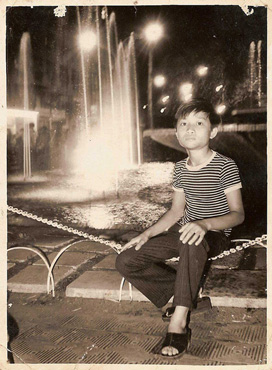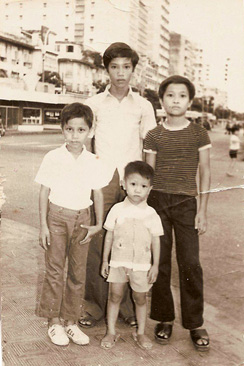Foreword
 April 12-13, 1979: A violent sea storm came just in time to chase away the Thai pirates in the evening. The men fought the storm all night by emptying the water from the boat with small buckets. (A block print from 1987 for my art class at University of Nebraska, Kearney).
April 12-13, 1979: A violent sea storm came just in time to chase away the Thai pirates in the evening. The men fought the storm all night by emptying the water from the boat with small buckets. (A block print from 1987 for my art class at University of Nebraska, Kearney).
After the Vietnam War ended on April 30, 1975, almost a million people escaped the communist regime by boat and fled to neighboring countries in the South China Sea. They faced numerous obstacles including pirate attacks, violent sea storms, dehydration and starvation. Many lives were lost. Those who were fortunate to survive the journey often ended up residing in refugee camps before immigrating to a non-communist country.
 Early April 1979: wearing new clothes for final portraits with my siblings in downtown Saigon several days before the boat escape from Vietnam.
Early April 1979: wearing new clothes for final portraits with my siblings in downtown Saigon several days before the boat escape from Vietnam.
In the beginning of April 1979, I was twelve years old when I left my family behind to begin one such dangerous journey with three of my older cousins. Along the way, our crowded boat of 68 people was repeatedly attacked by Thai pirates and endured a violent sea storm in total darkness throughout the night before a ship named Akuna saved us the following morning. The S.S. Akuna's captain and crew helped us reach Pulau Buton, a remote island in Indonesia that quickly became a refugee camp. With only the worn-out clothes on our bodies and without money, life at Pulau Buton camp was filled with many hardships and uncertainties.
 April 13, 1979 morning: The "Angel" ship named Akuna rescued 68 people on my boat several hours after we survived a violent sea storm and deadly pirate attacks in the Gulf of Thailand. (Watercolor painting I painted from memory, while living in a foster home in Nebraska, 1981).
April 13, 1979 morning: The "Angel" ship named Akuna rescued 68 people on my boat several hours after we survived a violent sea storm and deadly pirate attacks in the Gulf of Thailand. (Watercolor painting I painted from memory, while living in a foster home in Nebraska, 1981).
I was in emotional turmoil from the very beginning of my journey. I was extremely homesick, dearly missing my family. Additionally, I wrestled with feelings of guilt for the embarrassment placed upon my mother and father for accepting the financial gift from my uncle for my escape, as my parents were poor and didn’t have any money or gold to pay for it themselves. It was also hard not to consider myself a burden to my three cousins and the boat owner’s family who had to take care of me in the absence of my parents. I felt helpless and alone but very glad to be alive, albeit in a strange land.
A few weeks after arriving in Buton, a new refugee boat full of women and children made their way to our camp but was forced to remain offshore for several days because the Indonesian government was no longer accepting new arrivals. Everyone in sight looked for ways to intervene with the local authorities, but it was to no avail.
Up to this point, the last thing on my mind was the thought of going back on a boat and exposing myself, once again, to the many dangers of the open sea.
Then one day, a "Crazy American Cowboy" named Gary showed up and changed everything.
 May 1979 refugee ID photo: The Akuna took the people from our boat to resettle in a remote island called Pulau Buton. It quickly became one of several crowded refugee camps in Indonesia.
May 1979 refugee ID photo: The Akuna took the people from our boat to resettle in a remote island called Pulau Buton. It quickly became one of several crowded refugee camps in Indonesia.
. . . .

SHARE THIS
>> GO TO DESKTOP SITE
